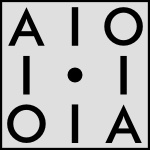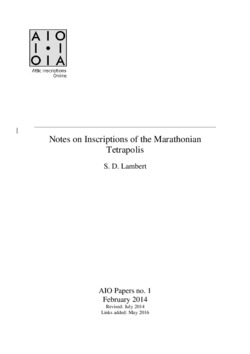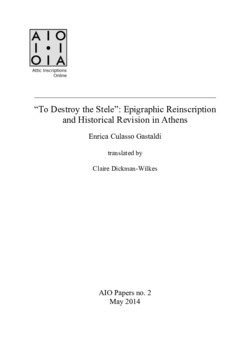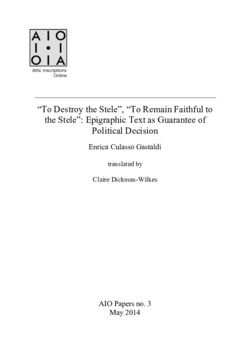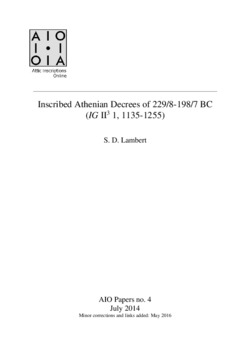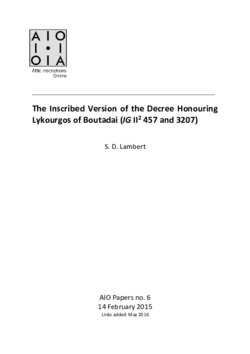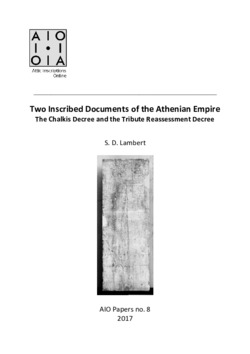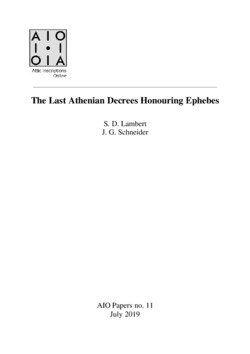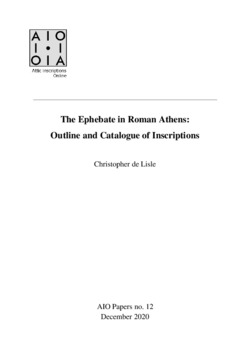AIO Papers
AIO Papers 1
Notes on Inscriptions of the Marathonian Tetrapolis - S. D. Lambert
This paper accompanies the publication on AIO of the inscriptions of the Marathonian Tetrapolis and is designed primarily to clarify the texts on which the translations are based. It reviews scholarship on the Tetrapolis’ sacrificial calendar (iv BC), published since my new edition, ZPE 130 (2000), 43-70, and makes some fresh observations. It also reviews the other inscriptions attributable to the Tetrapolis, IG I3 255, IG II2 2933, IG II2 1243, and an unpublished inscription.
View paperAIO Papers 2
"To Destroy the Stele”: Epigraphic Reinscription and Historical Revision in Athens - Enrica Culasso Gastaldi
This paper conducts a systematic survey, illustrated by many examples, of the practices of correction, erasure, destruction and re-inscription of inscribed texts in ancient Athens, and draws conclusions as to the political significance of these actions. It first appeared in Italian as “Abbattere la stele. Riscrittura epigrafica e revisione storica ad Atene”, Cahiers Glotz 14 (2003), 241-62, and is published here in a new English translation by Claire Dickman-Wilkes.
View paperAIO Papers 3
"To Destroy the Stele","To Remain Faithful to the Stele": Epigraphic Text as Guarantee of Political Decision - Enrica Culasso Gastaldi
This paper, which supplies a broader context for AIO Papers no. 2, shows, with many examples (particularly from Crete), that references to inscribed stelai in ancient Greece imply that the erection of a stele was regarded as not so much a record of political action, but as a political action in itself. It first appeared in Italian as “‘Abbattere la stele’, ‘Rimanere fedeli alla stele’. Il testo epigrafico come garanzia della deliberazione politica”, in A. Tamis, C. J. Mackie and S. G. Byrne eds., Philathenaios. Studies in Honour of Michael J. Osborne (Greek Epigraphical Society, Athens, 2010), 139-55, and is published here in a new English translation by Claire Dickman-Wilkes.
View paperAIO Papers 4
Inscribed Athenian Decrees of 229/8-198/7 BC (IG II3 1, 1135-1255) - S. D. Lambert
After exploring features of the history and methodology of Attic epigraphy, this paper surveys the corpus of 121 Athenian decrees of 229/8-198/7 BC recently published as IG II3 1, 1135-1255 (sections I-II of IG II3 1 fascicule 5). It reviews the decrees by category, discussing some historical aspects and proposing some improvements to the texts. It is designed to be read with the translations of these inscriptions published on AIO.
View paperAIO Papers 5
Accounts of Payments from the Treasury of Athena in 410-407? BC (IG I3 375 and 377) - S. D. Lambert
This paper treats the accounts of payments from the treasury of Athena in 410-407? BC which are inscribed on the front and back of the so-called Choiseul marble, in the Louvre in Paris (IG I3 375 and 377). It presents a fresh text of the difficult reverse face of the inscription (377), which prints only those readings on which the three rival texts currently in circulation are in agreement, and discusses the date. It is designed to support the translations of IG I3 375 and 377 published on AIO and includes an annotated table of the payments listed in these accounts.
View paperAIO Papers 6
The Inscribed Version of the Decree Honouring Lykourgos of Boutadai (IG II2 457 and 3207) - S. D. Lambert
This paper reviews the relationship between IG II2 457, the upper part of an Athenian decree of 307/6 BC honouring posthumously the orator Lykourgos of Boutadai, and IG II2 3207, the lower part of a stele inscribed with crowns commemorating decrees honouring Lykourgos passed in his lifetime. It finds that 3207 either belonged to the same stele as 457, as the great epigraphist Adolf Wilhlem proposed, or to a separate, but associated stele. In section 2 it investigates the decrees commemorated on 3207, locating them in the context of Lykourgos’ career, his rivalry with Demades and his relations with other politicians of the period.
View paperAIO Papers 7
The Last Erechtheion Building Accounts - S. D. Lambert with a contribution by J. D. Morgan
This paper presents up-to-date texts, informed by relevant work published since 2000, of the two extant sets of fragments of the building accounts of the Erechtheion in Ionic script as a basis for translations of these accounts published simultaneously on AIO. It reviews the date of these accounts, and presents a fresh argument by John Morgan to the effect that, if certain assumptions are made, no. 2 (IG I3 477) is datable to 405/4 BC. That would make it probably the latest extant account. Morgan also finds in this fragment a supporting argument for the position initially aired in AIO Papers 5, p. 3, that the Council's year and the archon's year were not made systematically coterminous in 407 BC, as had previously been thought, but continued to be out of step, probably until ca. 403 BC.
View paperAIO Papers 8
Two Inscribed Documents of the Athenian Empire: The Chalkis Decree and the Tribute Reassessment Decree - S. D. Lambert
This paper discusses two important inscriptions for the history of the Athenian Empire, the Chalkis decree of 446/5 (or 424/3?) BC (IG I3 40) and the tribute reassessment decree (“Thoudippos’ decree”) of 425/4 BC (IG I3 71). Based on English translations of the most up-to-date and authoritative Greek texts, the paper sets out to explain the inscriptions in historical context, without assuming prior knowledge of ancient Greek or of the history of Athens and the Athenian Empire. To help the reader new to the study of Athenian inscriptions, the Paper includes an introduction to inscribed Athenian decrees of the fifth century BC. This paper will be useful for researchers, teachers and learners of Greek History at University level, but is also designed to help 6th-form teachers and students in the UK with the study of these two inscriptions, which are set as source material for the “Relations between Greek states and between Greek and non-Greek states, 492-404 BC” period study under the OCR specification for A-level Ancient History (H407, for first assessment in 2019; LACTOR4 1.78 and 138). Note: minor corrections were incorporated on 28 June 2017. Hard copies are available through Andromeda Books.
View paperAIO Papers 9
357/6 BC: A Significant Year in the Development of Athenian Honorific Practice - S. D. Lambert
The main purpose of this short paper is to draw attention to the significance of 357/6 BC as the year that dedications by Athenian officials begin to refer to the crowning of officials by the Council and/or People (section 2). It also makes a case for lowering the accepted date at which the Athenians began honouring more than one Council prytany per year from ca. 340 BC to after 307/6 BC (section 3) and proposes consequential changes to the editions of some relevant inscriptions in IG II3 4 fasc. 1, mainly to dates (section 4). The paper concludes with a brief note on historical context (section 5).
View paperAIO Papers 10
Short Teaching Guide to Materials Available on Attic Inscriptions Online - S. D. Lambert
This paper is designed as a short guide for teachers and students to the materials available on Attic Inscriptions Online. After an overview, there are some Frequently Asked Questions, followed by brief lists of some key materials arranged by topic. The guide is updated regularly (last update: January 2020).
View paperAIO Papers 11
The Last Athenian Decrees Honouring Ephebes - S. D. Lambert and J. G. Schneider
The Athenian Council and/or Assembly regularly inscribed decrees in the Agora honouring the young men, or ephebes, who had performed national service, from the Chremonidean War (266/5 BC) through to the Augustan period. The last five of these monuments post-date the sack of Athens by Sulla in 86 BC, and a full set of the texts has not been available since 1916 (IG II2), since when the progress of scholarship has made it almost impossible for specialists, let alone non-specialist researchers and students, to obtain an overview of these important documents. This paper accompanies the publication on AIO of new Greek texts, based on autopsy, and annotated English translations, of all five monuments. For ease of future reference it includes complete Greek texts of the two most substantial sets of decrees, IG II2 1039 +, honouring the ephebes of 80/79 BC and their officers, and 1043 +, honouring the ephebes of 38/7 or 37/6 BC and their officers, with textual notes. Though most of the fragments of post-Sullan ephebic decrees are still in Athens, one (IG II2 1042 fr. b) is in the British Museum, and to accompany this paper we are also publishing a short video about this inscription on the AIO Youtube channel.
View paperAIO Papers 11B
The Last Athenian Decrees Honouring Ephebes. II. Photographic Documentation - S. D. Lambert and J. G. Schneider
This paper contains photographic documentation for AIO Papers 11. A larger pdf (38 MB) is available to any reader requiring higher definition images. Please apply directly to juliangabriel.schneider@gmx.ch.
View paperAIO Papers 12
The Ephebate in Roman Athens: Outline and Catalogue of Inscriptions - Christopher de Lisle
The ephebate was the system of public education which prepared young men for life as adult members of the community in Roman Athens, as in earlier periods of Athenian history. This paper provides an overview of the institution in the Roman period. Section 1 lays out the development of the ephebate and its epigraphic habit between two key events: the sack of Athens by Sulla in 86 BC and the sack of the city by the Heruli in 267 AD. Section 2 outlines the personnel who ran the ephebate: the annual magistrates who oversaw it, the permanent ephebic staff, and the ephebes themselves. Section 3 presents the activities of the ephebes in terms of political participation, athletics, military training, rhetoric and academic activities, and festivals. Section 4 discusses the ephebate’s role in citizenship and social status in Roman Athens. The paper concludes with a catalogue listing the 391 known ephebic inscriptions from between 86 BC and 267 AD.
View paper